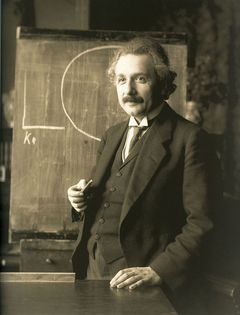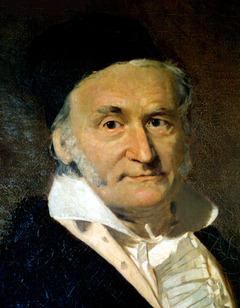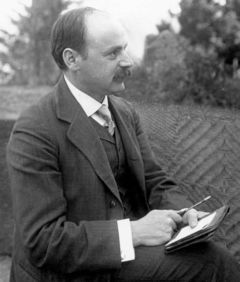100 Years of General Relativity (Part 2 of 3)
SCIENCE, 14 Dec 2015
Will Morrow, WSWS – TRANSCEND Media Service
“The views of space and time which I wish to lay before you have sprung from the soil of experimental physics, and therein lies their strength. They are radical. Henceforth space by itself, and time by itself, are doomed to fade away into mere shadows, and only a kind of union of the two will preserve an independent reality” —Hermann Minkowski, September 21, 1908
The History, Science and Implications of Einstein’s General Theory of Relativity
8 Dec 2015 – In 1905, Albert Einstein published the paper Zur Elektrodynamik bewegter Körper (On the Electrodynamics of Moving Bodies). In it, he provided the first part of the solution to a contradiction wracking 19th century physics which arose out of the study of electromagnetism and classical mechanics. Without modification, those two theories provided very different physical laws to observers moving at different speeds, an unacceptable idea when physics has as its starting point a reality independent from an observer.
The best minds in physics at the time were seeking to resolve this conflict, including Max Planck, Hendrik Lorenz, and Henri Poincare. While many came close, it was Einstein who set down concretely the two postulates that define the theory of special relativity: (1) The laws of physics are the same for all observers who are in inertial reference frames—that is, for all observers who are moving with respect to one another with constant velocity; and (2) The speed of light is constant for all observers in such reference frames.
The first of these laws was already central to Newtonian mechanics. The second, however, involved a fundamental revision of the Newtonian conception of space and time. Newton held that there was a fixed backdrop to the motions of the bodies in the Universe. In such a system, a single “clock” could measure the flow of time for all space, and a hypothetical infinite ruler could be used to maintain the spatial coordinates of all bodies.
Einstein on the other hand asserted that two different observers, traveling at different speeds, would both see light traveling away them at the same speed—contradicting the everyday experience of, for example, the speed of a train as seen by two observers moving at different speeds, one standing on the station platform, and the other traveling in a car in the opposite direction. As such, the measurements of distance and time by the two observers must be different. There is no longer a universal clock or set of rulers that all observers can agree on, as held by Newton, because observers moving at different speeds would each have their “own” clocks—ticking at different rates—and their “own” rulers—of different length.
Undaunted by its far-reaching implications, Einstein maintained the theory as the most correct way to resolve the conflict between mechanics and electromagnetism while preserving the equivalence of the physical laws experienced by all observers in inertial frames. Ultimately physical reality was the final test, vindicating the formulae derived from special relativity in thousands of experiments in the century since.
Einstein continued to consider the implications of his theory. He became increasingly dissatisfied by what he saw as an unjustified “preference” for observers in inertial—that is, non-accelerating—reference frames. Why was it, he asked, that the laws of physics should be the same for observers moving at constant velocity, but not those who are accelerating? Anyone who has felt becoming heavier as an elevator begins to accelerate upwards, or pushed outwards as a car turns a corner sharply, has experienced the physical consequences of acceleration. Yet, Einstein was driven by the materialist conception that the laws of physics of the universe must be the same, and therefore should be shown to have the same mathematical form, regardless of the reference frame of the observer in which they were expressed.
These questions were worked through further when Einstein was commissioned to write a review article on special relativity in the last months of 1907. It was while considering light in the presence of gravity that Einstein had what he later called the “happiest thought of my life,” which would lead to the unity of special relativity and gravity.
Since the pioneering experiments of Galileo Galilei, it had been known that all objects fall under gravity with the same acceleration, independently of their mass. Newton realized that this means mass can be described two ways: the resistance of an object to acceleration, and the quantity which determines the force felt by the object due to gravity. The mass of a car, for example, describes both how much force it takes to accelerate it, as well as the attraction that the car has to the Earth. This identity has been verified by repeated experiments by Newton in 1686, with further refinements by Lorand Eotvos in 1885. It remains a cornerstone of modern gravitational theory.
Einstein used this symmetry in 1907 to conduct the first major thought experiment leading to general relativity. He imagined a man placed inside an isolated room outside of a gravitational field with no means of seeing out, and then imagined the room accelerated upwards at a constant rate by an arbitrary force. Einstein noted that because the room was accelerating upwards, the man would feel a constant force downwards that was identical to that which he would feel standing under the force of gravity on Earth. Moreover, because all objects fall under gravity at the same rate, any experimental test conducted by the trapped observer would be unable to determine whether the downward force that he experienced—and that which made objects in the room fall to the floor as he dropped them—was really caused by the upward acceleration of the room, or was actually caused by a gravitational field.
This new postulate, the “Principle of Equivalence”, was stated by Einstein like so: “we … assume the complete physical equivalence of a gravitational field and a corresponding acceleration of the reference system.” That is, an observer moving in an accelerating reference frame can be assumed to be at rest so long as one also allows the presence of a gravitational field. This idea would prove central to the development of the theory of general relativity over the next eight years.
Though Einstein did not publish anything further on this topic until 1911, it remained in his own thinking and that of other physicists, with whom Einstein maintained correspondence, including the German theoretician Arnold Sommerfeld. In September 1909, at a meeting of physicists in Salzburg, Max Born presented a discussion of the problems posed by applying special relativity to rigid bodies that are rotating. Born was concerned that the disk would break apart as it sped up, noting as a result “that a [rigid] body at rest can never be brought into uniform rotation.”
A closely related problem was that an observer standing on a rotating circular platform would see the circumference of the platform shrink, thus changing the geometric constant pi. Einstein later argued that, by the principle of equivalence, one could view the acceleration one feels when standing on a rotating disk as a gravitational field. This thought experiment let pi remain constant, and implied that geometry and gravity are closely interrelated.
In July 1912, Einstein returned to Switzerland to assume a position at the Swiss Federal Institute of Technology (ETH) in Zurich, which he had previously attended as a student. It was while in Zurich that he fully realized the deep connection between geometry and gravity.
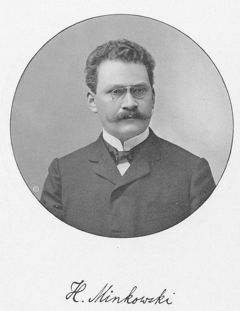
Hermann Minkowski, who first expressed relativity theory in a geometric, rather than algebraic, framework
The initial motivation for this work was inspired by the mathematician Hermann Minkowski, who in 1907 expressed special relativity in a primarily geometric, rather than algebraic, framework. Underlying this was a profound intellectual leap in which Minkowski expressed time not as a measure to order events, but as a coordinate which one travels through just as the standard three dimensions of space. This four dimensional system is known as “spacetime.”
While Einstein initially disregarded Minkowski’s contribution as a mathematical trick, he soon realized that it the first step towards incorporating gravity into special relativity. As such, he turned toward the mathematical theory of the geometry of curved surfaces which he had learned as a student at ETH.
The shifts in physics that had occurred in the 19th century were paralleled by a reexamination of the foundations of mathematics as part of the ongoing intellectual ferment spurred by the Enlightenment and the French Revolution of 1789. Just as the growth of modern capitalist industry and finance provided an enormous impetus to the natural sciences, it also aided in the struggle to more firmly develop their mathematical underpinnings.
Three major figures involved in this work were mathematicians Carl Friedrich Gauss, Janos Bolyai, and Nikolai Lobachevsky, who in the 1820s broke from the well-established notions of flat Euclidean geometry by describing positions on curved, rather than flat, surfaces. To take one example, this is akin to taking a grid drawn out on a piece of paper and folding it such that the lines can mold themselves onto a horse saddle. Bernhard Riemann refined this work in 1852 when he expanded the mathematical tools to describe not merely the coordinates on a curved surface but their underlying structure as well.
In 1912, Einstein later recalled: “I suddenly realized that Gauss’s theory … holds the key for unlocking this mystery. … I did not know at that time that Riemann had studied the foundations of geometry in an even more profound way. … I realized that the foundations of geometry have physical significance.” He turned to his old classmate, Marcel Grossman, now a professor of mathematics at ETH, to help him with the mathematical details of the theory. Grossman introduced Einstein to the work from the late 1800s of the Italian mathematicians Gregorio Ricci-Curbastro and Tullio Levi-Cevita on the theory of tensor calculus, which would provide the mathematical basis for expressing Einstein’s theory.
Using these tools, Einstein and Grossman within the space of a few intense months came to the essential feature of general relativity, that the presence of gravity was directly associated with the geometrical curvature of space and time. This also further generalized the work that had been done earlier regarding the problem of the rotating disk.
All that remained was to determine the equations governing the relationship between the curvature of space-time and the presence of mass and energy. This was crucial, as while it was clear since the time of Newton that a gravitational force was caused by a nearby mass, special relativity showed that mass and energy have an innate equivalence that had to be accounted for in general relativity. Adding to the complexity was that Einstein and Grossman knew that, in order to be correct, the equations had to reduce to Newtonian gravity in the low energy and low mass limits.
As a result of the challenges posed, Einstein and Grossman at first rejected what they would later realize were the correct equations of general relativity, and embarked on a search in a different direction, before returning to the correct path after two further years of work.
Einstein returned to Berlin in April 1914 to assume a professorship at Kaiser William University (now Humboldt University) in Berlin and as a member of the Prussian Academy of Sciences. He delivered his inaugural address on July 2, four days after the assassination of the Austrian Archduke Franz Ferdinand. World War I started 26 days later.
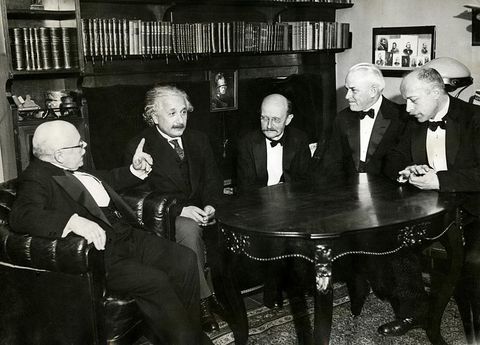
From left to right: physicists W. Nernst, A. Einstein, M. Planck, R.A. Millikan and von Laue in 1931
The educated elites, including artists, intellectuals, scientists, writers and other academics in Germany, were enlisted as part of the effort to provide an ideological justification for the war. In October, the so-called “Manifesto of the 93,” later published as an “Appeal to the civilized world,” appeared, seeking to justify the crimes of German military forces and glorify the war as a struggle for culture. Its signatories included, among others, the physicists Phillip Lenard, Walter Hermann Nernst, Wilhelm Wien and Max Planck.
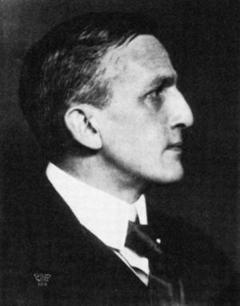
Georg Nicolai joined Einstein in writing a joint letter opposing the outbreak of World War I and its support by other German intellectuals
Shocked by the response of his colleagues to the war, Einstein along with physiologist Georg Friedrich Nicolai, astronomer Wilhelm Förster, and philosopher Otto Buek signed a pacifist counter-manifesto, titled “An appeal to Europeans.” While an act of considerable personal courage, little heed was paid to it at the time. In the spring of 1915, Einstein would comment on the behavior of his colleagues and other scholars during the war: “Will future centuries really be able to believe of our Europe that three centuries of assiduous cultural endeavor had brought no more progress than a transition from religious madness to national madness? Even the scholars of different countries are behaving as though their cerebrums had been surgically removed eight months ago.”
Against the backdrop of war, rationing and increasing scarcity of basic goods, Einstein completed the final equations of general relativity and published them in November 1915. According to the new theory, the presence of both matter and energy determined the shape, or curvature, of spacetime. From this standpoint, the geometric work of Minkowski on special relativity was shown to be a special case in which no matter, and hence curvature, was present.
The equations also gave a new way of thinking about motion caused by gravity. Instead of gravity being a force acting between two bodies, it was a natural consequence of matter causing spacetime to bend and warp. Matter then simply travels on the shortest curved path. When tested, the trajectories calculated for simple objects exactly matched what was given by Newton’s formulation.
However, general relativity went further. In a striking demonstration of the correctness of his new theory, Einstein calculated the precise offset to the orbit of Mercury which had eluded theoretical explanation within the framework of Newtonian gravity. This was the first test of general relativity and it passed with aplomb.
Karl Schwarzchild, a physicist and astronomer working on the Russian front calculating trajectories for artillery, immediately took up Einstein’s theory and provided the first exact solution to his equations, looking at how spacetime was curved by a massive, uncharged, non-rotating body. (The calculation of Mercury’s orbit had been done as an extremely good approximation.)
Schwarzchild wrote to Einstein from the Russian front on December 22, 1915 with his results: “As you see, the war treated me kindly enough, in spite of the heavy gunfire, to allow me to get away from it all and take this walk in the land of your ideas.” Einstein wrote back the following month: “I have read your paper with the utmost interest. I had not expected that one could formulate the exact solution of the problem in such a simple way. I liked very much your mathematical treatment of the subject. Next Thursday I shall present the work to the Academy with a few words of explanation.” Schwarzchild would die only four months later, at the age of 42, as a result of a disease contracted while serving on the front.
The most decisive triumph of Einstein’s new theory would not come until 1919. One of the predictions of general relativity is that the path of light itself would be bent in the presence of gravity. To prove this, the English physicist Sir Arthur Eddington, who had been an outspoken supporter of Einstein’s theory and promoted it in the English-speaking world despite the anti-German propaganda during the war, led expeditions to Principe, an island in the Gulf of Guinea off Africa, and Sobral, a city in the state of Ceará, Brazil to observe solar eclipses.
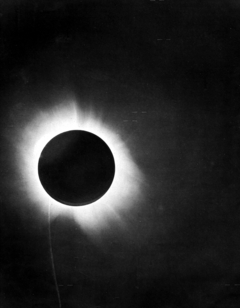
Eddington’s photo of the 1919 solar eclipse showing that the background stars were out of place, in line with the predictions of general relativity
Eddington was familiar with Einstein’s earlier calculation that the Sun was massive enough to show a noticeable bend in light rays from stars behind it. As such, he took images of the stars in the sky when the Sun was not present and compared them to images of the stars with the Sun present but blocked by the Moon (to see the stars during daytime). The results of the Principe expedition clearly showed a shift in the position of the light coming from the stars, closely matching the prediction of general relativity.
The official results of the experiment were announced on November 6, 1919, at a joint meeting of Royal Society and Royal Astronomical Society. The mathematician Alfred North Whitehead described the setting as the announcement was made as follows: “The whole atmosphere of tense interest was exactly that of Greek drama: we were the chorus commenting on the decree of destiny as disclosed in the development of a supreme incident. There was dramatic quality in the very staging; the traditional ceremonial, and in the background the picture of Newton to remind us that that greatest of scientific generalizations was now, after more than two centuries, to receive its first modification.”
DISCLAIMER: The statements, views and opinions expressed in pieces republished here are solely those of the authors and do not necessarily represent those of TMS. In accordance with title 17 U.S.C. section 107, this material is distributed without profit to those who have expressed a prior interest in receiving the included information for research and educational purposes. TMS has no affiliation whatsoever with the originator of this article nor is TMS endorsed or sponsored by the originator. “GO TO ORIGINAL” links are provided as a convenience to our readers and allow for verification of authenticity. However, as originating pages are often updated by their originating host sites, the versions posted may not match the versions our readers view when clicking the “GO TO ORIGINAL” links. This site contains copyrighted material the use of which has not always been specifically authorized by the copyright owner. We are making such material available in our efforts to advance understanding of environmental, political, human rights, economic, democracy, scientific, and social justice issues, etc. We believe this constitutes a ‘fair use’ of any such copyrighted material as provided for in section 107 of the US Copyright Law. In accordance with Title 17 U.S.C. Section 107, the material on this site is distributed without profit to those who have expressed a prior interest in receiving the included information for research and educational purposes. For more information go to: http://www.law.cornell.edu/uscode/17/107.shtml. If you wish to use copyrighted material from this site for purposes of your own that go beyond ‘fair use’, you must obtain permission from the copyright owner.
